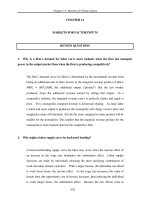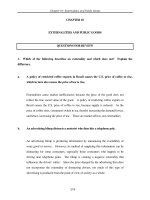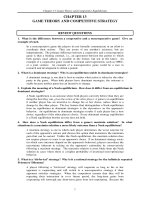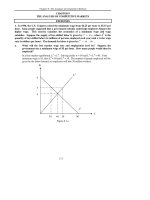Tài liệu Câu hỏi đánh giá môn Kinh tế vĩ mô bằng tiếng Anh- Chương 10 pptx
Bạn đang xem bản rút gọn của tài liệu. Xem và tải ngay bản đầy đủ của tài liệu tại đây (58.37 KB, 6 trang )
Chapter 10: Market Power: Monopoly and Monopsony
PART III
REVIEW QUESTIONS
1. A monopolist is producing at a point at which marginal cost exceeds marginal revenue.
How should it adjust its output to increase profit?
When marginal cost is greater than marginal revenue, the incremental cost of the
last unit produced is greater than incremental revenue. The firm would increase its
profit by not producing the last unit. It should continue to reduce production,
thereby decreasing marginal cost and increasing marginal revenue, until marginal
cost is equal to marginal revenue.
2. We write the percentage markup of prices over marginal cost as (P - MC)/P. For a
profit-maximizing monopolist, how does this markup depend on the elasticity of demand?
Why can this markup be viewed as a measure of monopoly power?
We can show that this measure of market power is equal to the negative inverse of
the price elasticity of demand.
PMC
PE
D
−
=−
1
The equation implies that, as the elasticity increases (demand becomes more
elastic), the inverse of elasticity decreases and the measure of market power
decreases. Therefore, as elasticity increases (decreases), the firm has less (more)
power to increase price above marginal cost.
3. Why is there no market supply curve under conditions of monopoly?
The monopolist’s output decision depends not only on marginal cost, but also on the
demand curve. Shifts in demand do not trace out a series of prices and quantities
138
Chapter 10: Market Power: Monopoly and Monopsony
139
that we can identify as the supply curve for the firm. Instead, shifts in demand
lead to changes in price, output, or both. Thus, there is no one-to-one
correspondence between the price and the seller’s quantity; therefore, a
monopolized market lacks a supply curve.
4. Why might a firm have monopoly power even if it is not the only producer in the
market?
The degree of monopoly (or market) power enjoyed by a firm depends on the
elasticity of the demand curve that it faces. As the elasticity of demand increases,
i.e., as the demand curve becomes flatter, the inverse of the elasticity approaches
zero and the monopoly power of the firm decreases. Thus, if the firm’s demand
curve has any elasticity less than infinity, the firm has some monopoly power. It is
only the competitive firm that faces a horizontal demand curve who has no market
power.
5. What are some of the different types of barriers to entry that give rise to monopoly power?
Give an example of each.
The firm’s ability to exercise monopoly power depends on how easy it is for other
firms to enter the industry. There are several barriers to entry, including exclusive
rights (e.g., patents, copyrights, and licenses) and economies of scale. These two
barriers to entry are the most common. Exclusive rights are legally granted
property rights to produce or distribute a good or service. Positive economies of
scale lead to “natural monopolies” because the largest producer can charge a lower
price, driving competition from the market. For example, in the production of
aluminum, there is evidence to suggest that there are scale economies in the
conversion of bauxite to alumina. (See U.S. v. Aluminum Company of America,
148 F.2d 416 [1945], discussed in Exercise 8, below.)
6. What factors determine the amount of monopoly power an individual firm is likely to
have? Explain each one briefly.
Chapter 10: Market Power: Monopoly and Monopsony
140
Three factors determine the firm’s elasticity of demand: (1) the elasticity of
market demand, (2) the number of firms in the market, and (3) interaction among
the firms in the market. The elasticity of market demand depends on the
uniqueness of the product, i.e., how easy it is for consumers to substitute away from
the product. As the number of firms in the market increases, the demand elasticity
facing each firm increases because customers may shift to the firm’s competitors.
The number of firms in the market is determined by how easy it is to enter the
industry (the height of barriers to entry). Finally, the ability to raise the price
above marginal cost depends on how other firms react to the firm’s price changes.
If other firms match price changes, customers will have little incentive to switch to
another supplier.
7. Why is there a social cost to monopoly power? If the gains to producers from monopoly
power could be redistributed to consumers, would the social cost of monopoly power be
eliminated? Explain briefly.
When the firm exploits its monopoly power by charging a price above marginal
cost, consumers buy less at the higher price. Consumers enjoy less surplus, the
difference between the price they are willing to pay and the market price on each
unit consumed. Some of the lost consumer surplus is not captured by the seller
and is a deadweight loss to society. Therefore, if the gains to producers were
redistributed to consumers, society would still suffer the deadweight loss.
8. Why will a monopolist’s output increase if the government forces it to lower its price?
If the government wants to set a price ceiling that maximizes the monopolist’s output, what
price should it set?
By restricting price to be below the monopolist’s profit-maximizing price, the
government can change the shape of the firm’s marginal revenue, MR, curve.
When a price ceiling is imposed, MR is equal to the price ceiling for all quantities
lower than the quantity demanded at the price ceiling. If the government wants to
maximize output, it should set a price equal to marginal cost, or in other words set
price at the point where the demand curve and the marginal cost curve intersect.
Chapter 10: Market Power: Monopoly and Monopsony
141
Prices below this level induce the firm to decrease production, assuming the
marginal cost curve is upward sloping. The regulator’s problem is to determine
the shape of the monopolist’s marginal cost curve. This task is difficult given the
monopolist’s incentive to hide or distort this information.
9. How should a monopsonist decide how much of a product to buy? Will it buy more or
less than a competitive buyer? Explain briefly.
The marginal expenditure is the change in the total expenditure as the purchased
quantity changes. For a firm competing with many firms for inputs, the marginal
expenditure is equal to the average expenditure (price). For a monopsonist, the
marginal expenditure curve lies above the average expenditure curve because the
decision to buy an extra unit raises the price that must be paid for all units,
including the last unit. All firms should buy inputs so that the marginal value of
the last unit is equal to the marginal expenditure on that unit. This is true for both
the competitive buyer and the monopsonist. However, because the monopsonist’s
marginal expenditure curve lies above the average expenditure curve and because
the marginal value curve is downward sloping, the monopsonist buys less than a
firm would buy in a competitive market.
10. What is meant by the term “monopsony power”? Why might a firm have monopsony
power even if it is not the only buyer in the market?
Monopsony power refers to the buyer’s ability to affect the price of a good. This
power enables the buyer to purchase the good for a lower price, as compared to a
competitive factor market. Any buyer facing an upward-sloping factor supply
curve has some monopsony power. In a competitive market, the seller faces a
perfectly-elastic market demand curve and the buyer faces a perfectly-elastic market
supply curve. Thus, any characteristic of the market (e.g., when there are a small
number of buyers or if buyers engage in collusive behavior) that leads to a less-
than-perfectly-elastic supply curve gives the buyer some monopsony power.
Chapter 10: Market Power: Monopoly and Monopsony
142
11. What are some sources of monopsony power? What determines the amount of
monopsony power an individual firm is likely to have?
The individual firm’s monopsony power depends on the characteristics of the
“buying-side” of the market. There are three characteristics that enhance
monopsony power: (1) the elasticity of market supply, (2) the number of buyers,
and (3) how the buyers interact. First, if market supply is very inelastic, then the
buyer will enjoy more monopsony power. When supply is very elastic, marginal
expenditure and average expenditure do not differ by much, so price will be closer
to the competitive price. Second, the fewer the number of buyers, the greater the
monopsony power. Third, if buyers are able to collude and/or they do not compete
very aggressively with each other then each will enjoy more monopsony power.
12. Why is there a social cost to monopsony power? If the gains to buyers from
monopsony power could be redistributed to sellers, would the social cost of monopsony power
be eliminated? Explain briefly.
With monopsony power, the price is lower and the quantity is less than under
competitive buying conditions. Because of the lower price and reduced sales,
sellers lose revenue. Only part of this lost revenue is transferred to the buyer as
consumer surplus, and the net loss in total surplus is deadweight loss. Even if the
consumer surplus could be redistributed to sellers, the deadweight loss persists.
This inefficiency will remain because quantity is reduced below the level where
price is equal to marginal cost.
13. How do the antitrust laws limit market power in the United States? Give examples of
major provisions of the laws.
Antitrust laws, which are subject to interpretation by the courts, limit market power
by proscribing a firm’s behavior in attempting to maximize profit. Section 1 of the
Sherman Act prohibits every restraint of trade, including any attempt to fix prices
by buyers or sellers. Section 2 of the Sherman Act prohibits behavior that leads to
monopolization. The Clayton Act, with the Robinson-Patman Act, prohibits price
Chapter 10: Market Power: Monopoly and Monopsony
143
discrimination and exclusive dealing (sellers prohibiting buyers from buying goods
from other sellers). The Clayton Act also limits mergers when they could
substantially lessen competition. The Federal Trade Commission Act makes it
illegal to use unfair or deceptive practices.
14. Explain briefly how the U.S. antitrust laws are actually enforced.
Antitrust laws are enforced in three ways: (1) through the Antitrust Division of the
Justice Department, whenever firms violate federal statutes, (2) through the Federal
Trade Commission, whenever firms violate the Federal Trade Commission Act, and
(3) through civil suits. The Justice Department can seek to impose fines or jail
terms on managers or owners involved or seek to reorganize the firm, as it did in its
case against A.T.& T. The FTC can seek a voluntary understanding to comply
with the law or a formal Commission order. Individuals or companies can sue in
federal court for awards equal to three times the damage arising from the anti-
competitive behavior.









